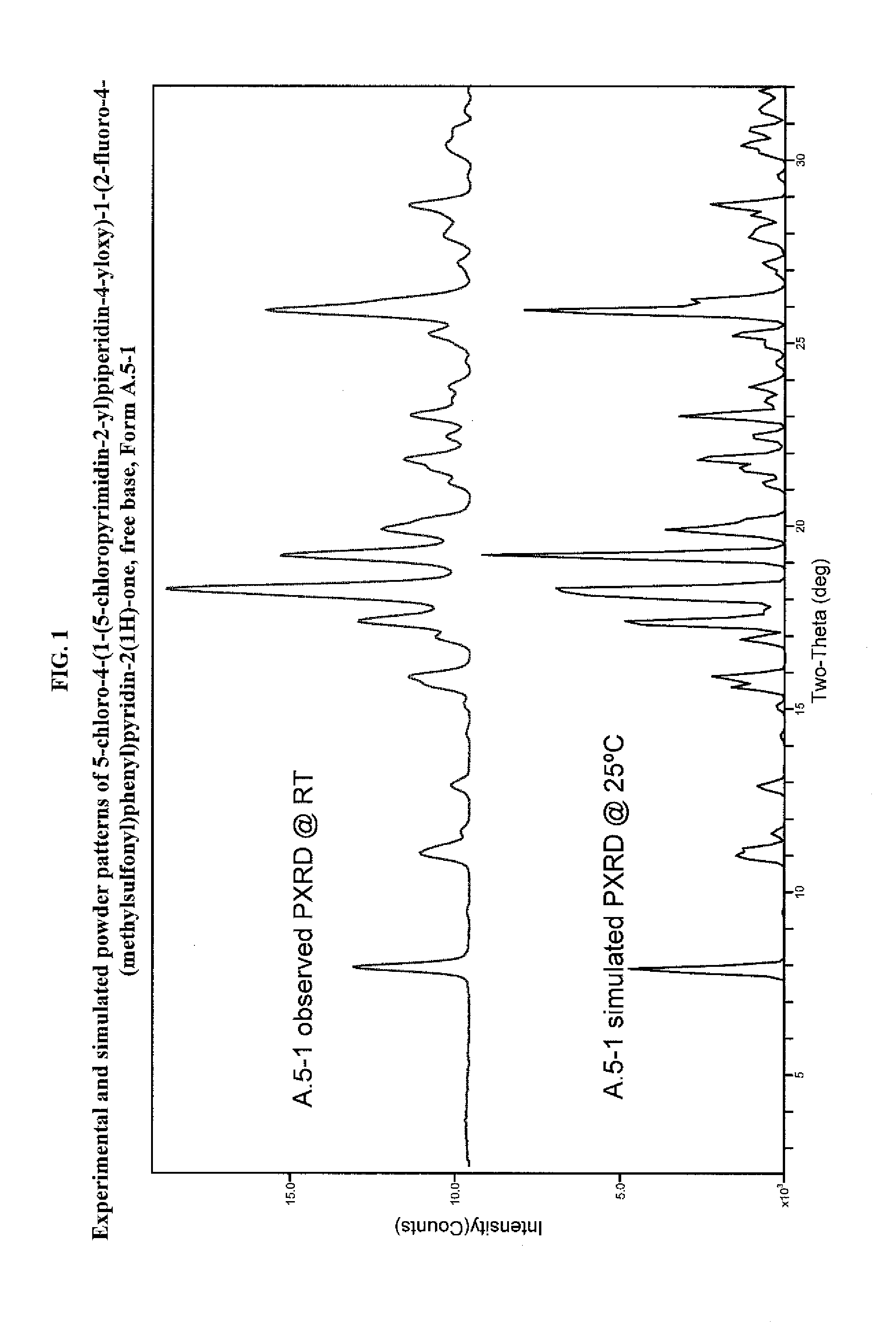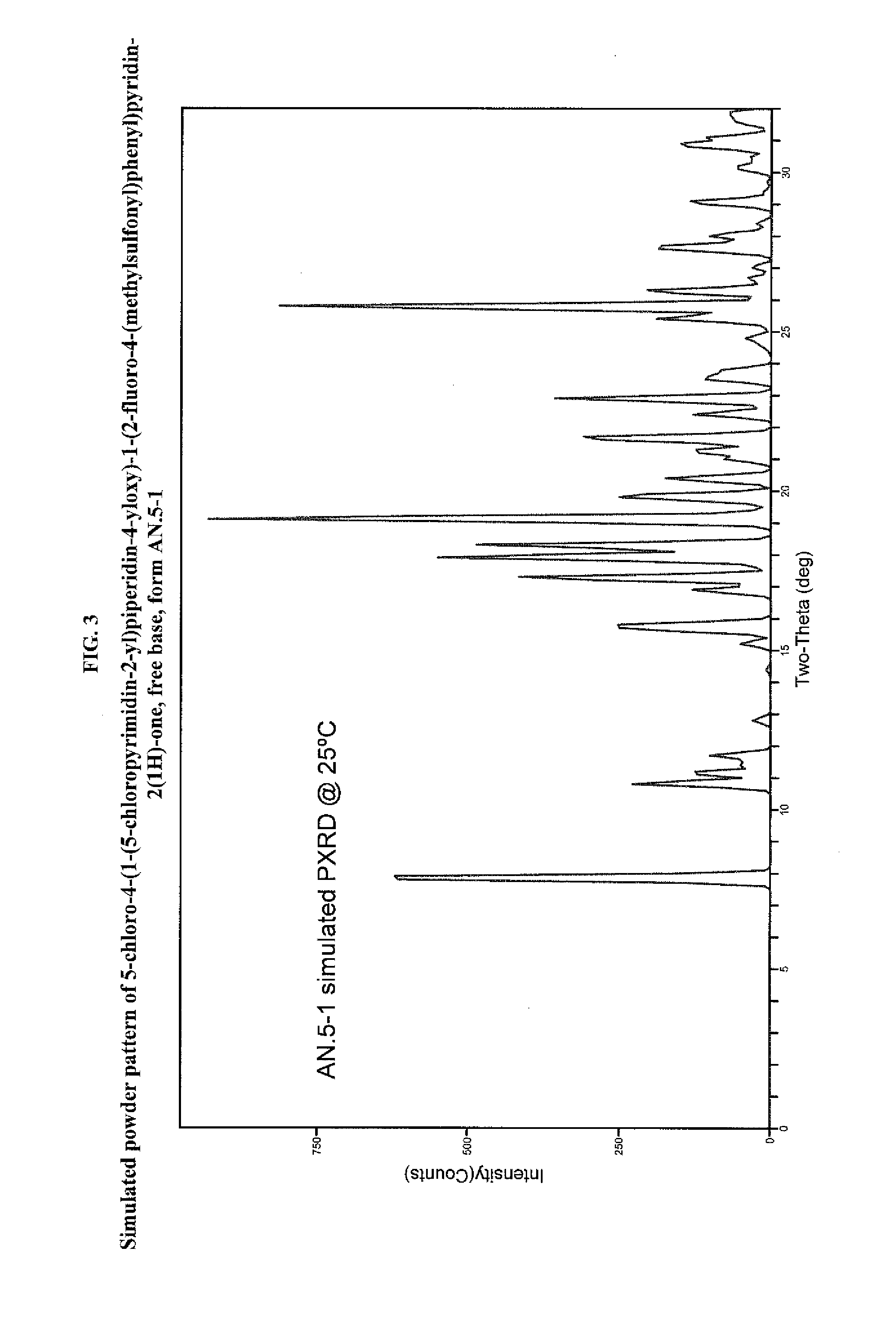Pyrimidinylpiperidinyloxypyridinone analogues as gpr119 modulators
- Summary
- Abstract
- Description
- Claims
- Application Information
AI Technical Summary
Benefits of technology
Problems solved by technology
Method used
Image
Examples
example 1
5-Chloro-1-(4-(methylsulfonyl)phenyl)-4-(1-(5-(trifluoromethyl)pyrimidin-2-yl)piperidin-4-yloxy)pyridin-2(1H)-one
[0219]
[0220]To a 200 mL recovery flask under nitrogen was added Intermediate 1 (2.997 g, 10.00 mmol), Intermediate 2 (2.72 g, 11.00 mmol), triphenylphosphine (3.41 g, 13.00 mmol), and THF (5 mL) to produce a tan-amber suspension. To this mixture was added (E)-diethyl diazene-1,2-dicarboxylate (2.055 mL, 12.98 mmol) over 1 minute. A small amount of heat was generated and the color became dark brown. Within two minutes, most of the solids had dissolved. By 10 minutes, a thick, tan-brown precipitate had formed. After 15 minutes, 100 mL of ether was added. The thick tan suspension was stirred for 5 minutes, filtered, and the solids washed with 4×15 mL of ether to give 4.19 g of a tan powder. This material was loaded onto a 70 mm id×110 mm silica gel column as a suspension and eluted as follows:
FractionVolumeSolventA1.8L75% Ethyl acetate / hexaneB0.7L100% Ethyl acetate1-2125mL10...
example 2
5-Chloro-1-(2-fluoro-4-(methylsulfonyl)phenyl)-4-(1-(5-(trifluoromethyl)pyrimidin-2-yl)piperidin-4-yloxy)pyridin-2 (1H)-one
[0222]
[0223]To a 4 mL vial was added a 60% oil dispersion of sodium hydride (53 mg, 1.33 mmol), DMF (10 mL), and Intermediate 3 (250 mg, 0.67 mmol). The mixture was stirred at room temperature for 30 minutes and then 1,2-difluoro-4-(methylsulfonyl)benzene (192 mg, 1.00 mmol) was added. The mixture was heated at 100° C. for 12 hours. After cooling to room temperature, the reaction mixture was diluted with ethyl acetate (40 mL) and washed with water three times. The organic layer was collected, dried over sodium sulfate, and filtered. The residue obtained was purified by flash chromatography (silica gel, 0-100% ethyl acetate / hexane) to give Example 2 (139 mg, 37% yield) as a yellow solid. 1H NMR (DMSO-d6, 500 MHz) δ 8.72 (2H, s), 8.11 (1H, s), 7.97-8.06 (1H, m), 7.78-7.95 (2H, m), 6.31 (1H, s), 4.90-5.01 (1H, m), 4.06-4.22 (2H, m), 3.74-3.89 (2H, m), 3.36 (3H, s),...
example 3
5-Chloro-1-(3-fluoro-4-(methylsulfonyl)phenyl)-4-(1-(5-(trifluoromethyl)pyrimidin-2-yl)piperidin-4-yloxy)pyridin-2(1H)-one
[0224]
[0225]A mixture of a 60% oil dispersion of sodium hydride (34 mg, 0.87 mmol), Intermediate 3 (216 mg, 0.58 mmol), and DMF (10 mL) was stirred at room temperature for 30 minutes. 2,4-Difluoro-1-(methylsulfonyl)benzene (144 mg, 0.75 mmol) was added and the mixture was heated at 100° C. for 16 hours. After cooling to room temperature, the crude mixture was diluted with ethyl acetate and washed with water three times. The organic layer was dried with sodium sulfate, filtered, and concentrated. The residue obtained was purified by flash chromatography (silica gel, 0-100% ethyl acetate / hexane) to give Example 3 (80 mg, 25% yield) as yellow solid. 1H NMR (500 MHz, CDCl3) δ 8.53 (s, 2H), 8.10 (t, J=7.70 Hz, 1H), 7.32-7.49 (m, 3H), 6.06 (s, 1H), 4.67-4.79 (m, 1H), 3.99-4.19 (m, 4H), 3.25 (s, 3H), 1.91-2.16 (m, 4H); MS (ESI) 547.2 (M+H).
PUM
| Property | Measurement | Unit |
|---|---|---|
| Volume | aaaaa | aaaaa |
| Volume | aaaaa | aaaaa |
| Molar density | aaaaa | aaaaa |
Abstract
Description
Claims
Application Information
 Login to View More
Login to View More - R&D
- Intellectual Property
- Life Sciences
- Materials
- Tech Scout
- Unparalleled Data Quality
- Higher Quality Content
- 60% Fewer Hallucinations
Browse by: Latest US Patents, China's latest patents, Technical Efficacy Thesaurus, Application Domain, Technology Topic, Popular Technical Reports.
© 2025 PatSnap. All rights reserved.Legal|Privacy policy|Modern Slavery Act Transparency Statement|Sitemap|About US| Contact US: help@patsnap.com



